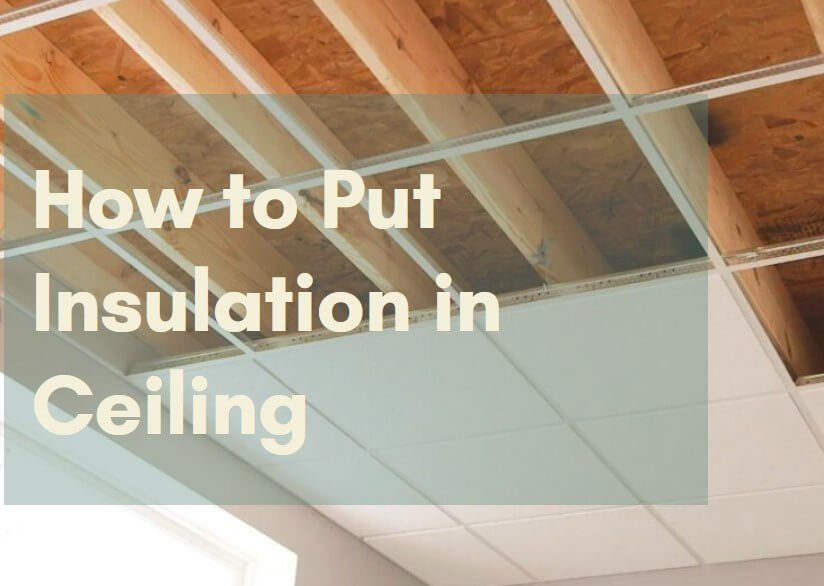Installing quality ceiling insulation, such as in an unfinished basement or main living areas, is essential for a cozier home in winter and relief from the heat in summer. A home lacking proper insulation can lose up to a fifth of its energy through the roof, making effective insulation a key factor in energy conservation.
Ceiling thermal insulation reduces the amount of heat energy lost through convection and conduction, allowing you to relax in a more comfortable environment.

However, there are numerous types of ceiling insulation available. But the question is, ‘how to put insulation in the ceiling?’ We will assist you in finding out how to put insulation in the ceiling.
How to Put Insulation in Basement Ceiling
If your interior floors are cold, and your basement is frigid, but your house is warm, you would think that insulating your basement ceiling is the obvious solution. Also, many would like to insulate their basement to make it soundproof.
Therefore, before you insulate your basement, define your objective first, then, you might have a material of choice for your insulation.
- Choosing the material
Fiberglass, spray foam (including those with Ecose technology), and blanket insulation are the three primary materials available for ceiling insulation.
When choosing the right material, consider your budget and the specific goals for your project, such as whether you’re insulating an unfinished basement or another area of your home. This will assist you in determining which insulating material is ideal for you.
- Area Measurement
What is the exact amount of basement ceiling insulation you require? To figure out how much insulation you’ll need, you’ll need to know the exact dimensions of your basement. Removing insulation from a surface after it has been applied is extremely difficult.
That is why you must measure all the places and take down all the measurements before installing the insulation.
- Cover the Insulation
You must cover all of them, whether installing fiberglass, spray foam, or blanket insulation. Otherwise, they will not function long and will also be unsightly. So, after you’ve installed the insulation in your basement ceiling, you’ll need to drywall over it.
When you insulate your basement ceiling, the warm air that would normally radiate from your interior floors to the basement is slowed, reducing the temperature in the cellar even more and increasing the risk of moisture issues or frozen pipes in the winter. In addition, you do not save nearly as much money on your energy bill as you had hoped.
Unfaced fiberglass batts or blankets can simply use your basement ceiling insulation between the floor joists and be held in place using wire, fishing line, or spring metal supports known as “tiger claws.” This is how you put insulation in the basement ceiling.
How to Install Insulation in a Finished Attic Ceiling
Insulation in an unfinished attic is to keep the rooms below cool in the summer and warm in the winter. That involves installing roof vents and insulating only the attic floor, not the walls. Insulation in a finished attic is required to keep the attic sections pleasant.
Read also: How to Install Rigid Foam Insulation
A finished attic can be insulated in one of two ways. If you’re simply going to insulate the living space, wrap the insulation around the room’s walls and ceiling before continuing along the non-living section’s floor. The area behind the knee wall will be extremely hot or chilly.
Or you can apply insulation from the roofline all the way down to the floor to keep the area behind the sidewalls from freezing in the winter.
For the unfinished attic ceiling insulation, you can follow these steps;
- To avoid trampling on the insulation you just installed, work from the perimeter of the attic toward the door or hatch.
- Always insulate the tops of the ceiling joists to ensure that the insulation is deep enough to achieve your desired R-value and avoid thermal bridging heat loss through the wood framing.
- After you’ve finished for the day, shower properly to eliminate fibers from your skin, and wash your work clothing after each use.
Key Considerations for Effective Ceiling Insulation
Understanding the specific requirements of your ceiling space is crucial when selecting insulation. For instance, in an unfinished basement, you might need insulation with a vapor barrier or perforated facing to manage moisture effectively.
Additionally, it’s important to be aware of the building code requirements in your area to ensure that your insulation meets all necessary standards for safety and efficiency.
Read also: How Thick Should Attic Insulation Be
Conclusion
In conclusion, knowing how to install insulation in a ceiling is a valuable skill for homeowners looking to enhance their home’s comfort and energy efficiency. Whether you’re working with an unfinished basement or a finished attic, selecting the right insulation material and understanding the installation process are key to achieving optimal results.
After learning how to put insulation in the ceiling, you can insulate the ceiling like an expert if you have a natural flair for home repair projects. However, if any of the processes are unclear, you may always contact a professional to help minimize errors during the application.


